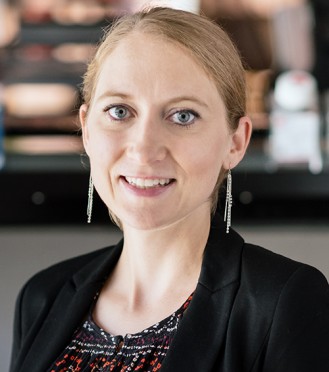Gladstone NOW: The Campaign Join Us on the Journey✕

For Cancer Immunotherapy Month, Karin Pelka answers questions about how immunotherapy can treat patients with solid tumors and the challenges that scientists are working to overcome.
Nearly 2 million people in the US will be diagnosed with cancer this year. For 90 percent of those cases in adults, the cancer will take the form of solid tumors, such as those found in breast, lung, or prostate cancer.
Immunotherapy—a revolutionary treatment that uses the body’s own immune system to recognize, target, and destroy cancer cells—has changed the landscape of cancer treatment over the past few years. Not only does it offer better quality of life during treatment, presenting fewer side effects than chemotherapy and radiation, but it has also vastly improved treatment outcomes for patients with certain cancers. Some people have even been cured. But for most solid tumors, immunotherapy hasn’t been very successful thus far.
For Cancer Immunotherapy Month, we spoke with Gladstone Investigator Karin Pelka, PhD, to find out what scientists are doing to expand the benefits of immunotherapy to currently unresponsive solid tumors.
Why is immunotherapy a promising treatment option for cancer?
For many cancer treatments, one of the major challenges is addressing the fact that cancer evolves and develops a resistance to the therapy. Immunotherapy is exciting because it creates a weapon that can evolve alongside the tumor and keep it in check. It works as a living therapy, either by empowering the patient’s own immune system—using drugs known as checkpoint inhibitors—or through the injection of modified immune cells, such as CAR T cells, that fight cancer more effectively.
“Unfortunately, immunotherapy doesn’t quite work yet for the majority of solid tumors. So, I see a huge area of opportunity to find better ways to treat solid tumors.”
These strategies have revolutionized the treatment of many blood cancers, as well as certain types of skin and lung cancers. This is impressive progress, and immunotherapy is now an established pillar in cancer treatment.
Unfortunately, immunotherapy doesn’t quite work yet for the majority of solid tumors. So, I see a huge area of opportunity to find better ways to treat solid tumors.
Why are most solid tumors difficult to treat with immunotherapy?
Our immune system is designed and trained to distinguish self from non-self. Because of this, it can effectively fight infections while sparing our healthy tissues and preventing excessive inflammation. If a tumor looks very different from our healthy tissue, our immune system can detect and fight it, particularly with some help from immunotherapy. This is why tumors with many mutations, like melanoma or lung cancer, respond well to the therapy. But most tumors are not that easy for our immune system to spot.
Another reason is that most solid tumors develop gradually and acquire really complex structures, almost like a new organ. A tumor is made up of cancer cells as well as stroma cells, which support the tumor like scaffolding and form physical barriers. The tumor creates its own environment, which can exclude or shut off certain types of immune cells. Other immune cells are tricked into helping the tumor grow.
Lastly, each tumor is unique. In two patients with the same type of tumor, the tumors might look completely different. And even within the same patient, different parts of the tumor may look dissimilar. This heterogeneity has made it very difficult for us to understand the rules that govern solid tumors. And it has made it really difficult to engineer CAR T cells that can detect and destroy all cells in a solid tumor. In contrast, targeting CAR T cells toward certain types of blood cancers has been much easier.
Tell us about the advances being made to improve the effectiveness of CAR T-cell therapy, one of the most advanced types of immunotherapy, for solid tumors.
Many of my colleagues in the Gladstone-UCSF Institute of Genomic Immunology are systematically screening for genetic modifications that make CAR T cells much more potent and resistant to the harsh environment in solid tumors. They’re also designing smart ways to direct CAR T cells toward tumors and away from healthy tissues.

Pelka’s lab is using the latest technologies to understand what solid tumors actually look like—this knowledge will eventually help design better treatments.
Together, we’re also trying to use CAR T cells not only as the actual killers of cancer cells, but to re-educate and re-organize the body’s immune response against a tumor. In this way, we hope to make use of the full repertoire of our immune system to eliminate cancer cells that are not directly attacked by the CAR T cells themselves. This could be much more effective.
What has informed these strategies?
Many researchers, including in my lab, are using the latest technologies to profile solid tumors and understand what they actually look like. This work allows us to understand how the tumor and the immune system co-evolve, and what the difference is between successful and failed treatments.
We have now done this with a lot of tumors, and have started to see certain patterns, despite the fact that individual tumors are quite different from one another. And it makes sense, because even though the cancer cells evolve differently in each patient, the constraints are still somewhat similar. Cancer cells need to multiply and break through tissue barriers. And we all have an immune system that will put some sort of pressure on the cancer cells to “look normal,” or hijack mechanisms that shut down the immune response. Understanding all of this better really helps in designing better treatments.
Why is it important to understand the cells that make up a tumor?
There’s a lot of back-and-forth communication between our immune system and cancer cells. As cancer cells evolve, they send instructions to our immune cells, or shut them down entirely. This interaction is complex because so many different cell types are involved.
Right now, there’s just not enough knowledge to rationally design a therapy that shifts the entire network to a productive antitumor response. Immunotherapy trials are kind of poking around, trying different things to see what might work. To develop more effective therapies, we need to understand how cells in the network are connected and working together. Then we could actually predict what would happen to the network if we made a change to one cell.
“In a recent trial for a specific subtype of locally advanced rectal cancer, the results have been just amazing. It shows how promising immunotherapy can be.”
Ultimately, it may not be possible to find one treatment that solves it all. But if we can predict how the cancer and our immune system will react to a therapy, then we can design a combination treatment that forces the cancer into a corner and then offers the final blow that destroys it completely.
What technologies are accelerating the field?
We rely on all the latest genomic and sequencing tools to look at tumors at single-cell resolution, as well as CRISPR gene editing technology to modify molecules within the network very precisely.
Another powerful technology is to grow organoids—miniature, three-dimensional cell clusters that mimic real organs—from the patients’ tumors. These organoids serve as avatars and can be used to test treatments in models that better reflect human tumors. In my lab, we also use organoids transplanted to mice to understand tumors at different metastatic sites.
We also collaborate with machine learning experts in the Gladstone Institute of Data Science and Biotechnology to train AI models of the tumor immune networks. We hope these models will enable us to predict genes in which cells are likely to trigger potent anti-tumor responses when targeted therapeutically.
Do you know of any recent successes in using immunotherapy to treat solid tumors?
Yes! As a field, we’ve started putting more consideration into the timing of treatments, which I think is key. Given that it’s relatively new, immunotherapy has often been offered as part of clinical trials to patients in the late stages of cancer, after all other available treatments have failed. But that’s not the best setting for these therapies to work, as patients’ immune systems have already taken a beating. At the same time, immunotherapies often have milder adverse effects compared to other treatments. So, exploring their impact in patients with earlier disease stages makes a lot of sense.
In a recent trial for a specific subtype of locally advanced rectal cancer, the results have been just amazing. Patients with this type of cancer usually undergo chemotherapy, radiation, and surgery—all of which are really life altering. In the trial, the patients received immunotherapy before any other treatment. The amazing thing is, all patients had complete responses to the immunotherapy alone, with no evidence of their cancer left. So, they did not need any other treatments.
To me, it’s so remarkable. And it shows how promising immunotherapy can be.
Gladstone NOW: The Campaign
Join Us On The Journey
How Do Vaccines Work?
How Do Vaccines Work?
An in-depth explainer about different types of vaccines and what happens in the body after vaccination.
Gladstone Experts COVID-19 Deep DiveOur Research Is Explicitly Focused on Solving Disease | The Gladstone Difference
Our Research Is Explicitly Focused on Solving Disease | The Gladstone Difference
Gladstone unites more than 600 biologists, chemists, engineers, and data scientists, combining diverse expertise to uncover how the human body functions—and what drives disease.
Gladstone Experts Institutional NewsInside the Brain: Tackling Neurological Disease at Its Roots
Inside the Brain: Tackling Neurological Disease at Its Roots
For World Brain Day, discover some of Gladstone’s latest breakthroughs in neurological research.
Gladstone Experts Research (Publication) Alzheimer’s Disease COVID-19 Parkinson’s Disease Neurological Disease Akassoglou Lab Corces Lab Huang Lab Mucke Lab




